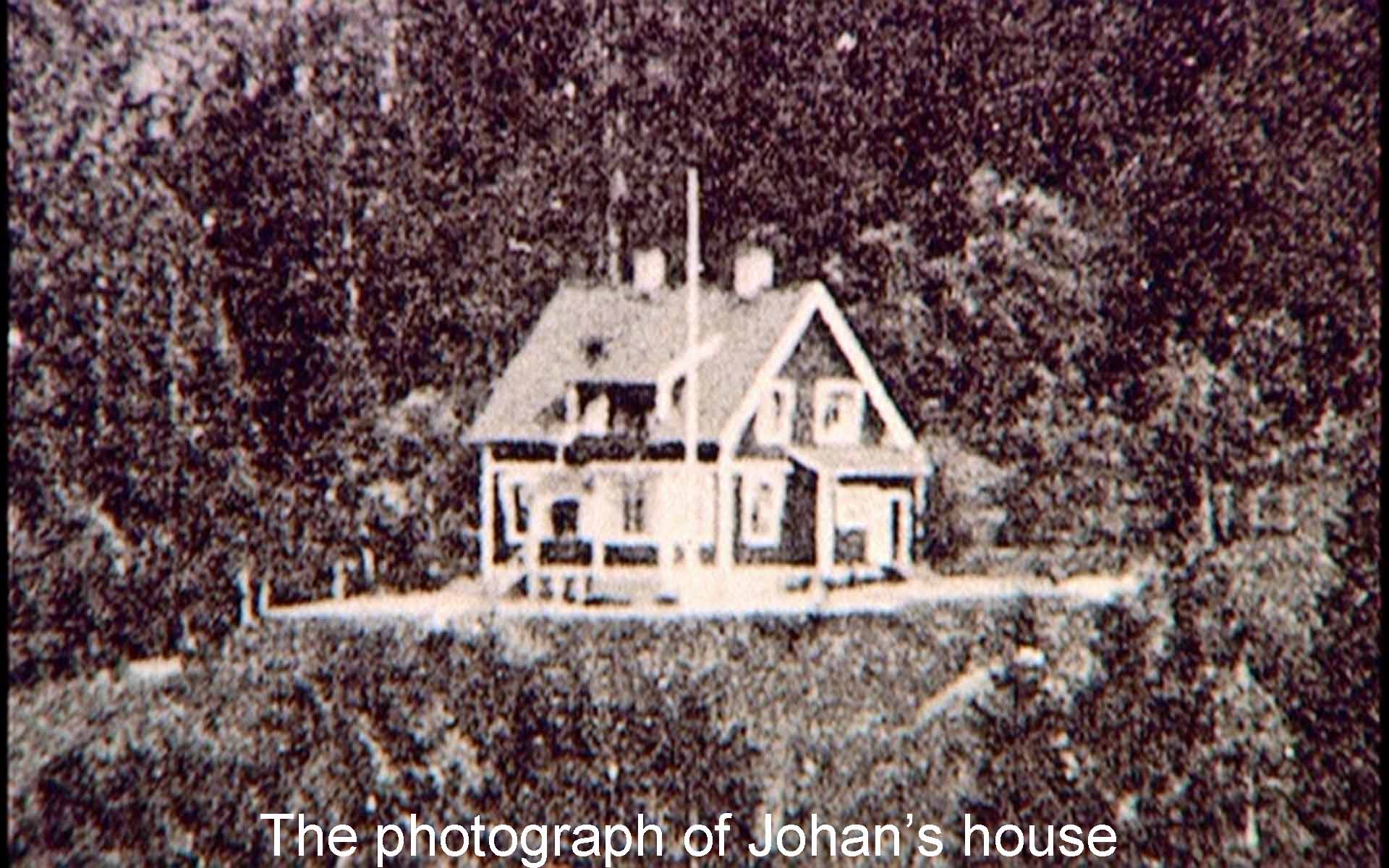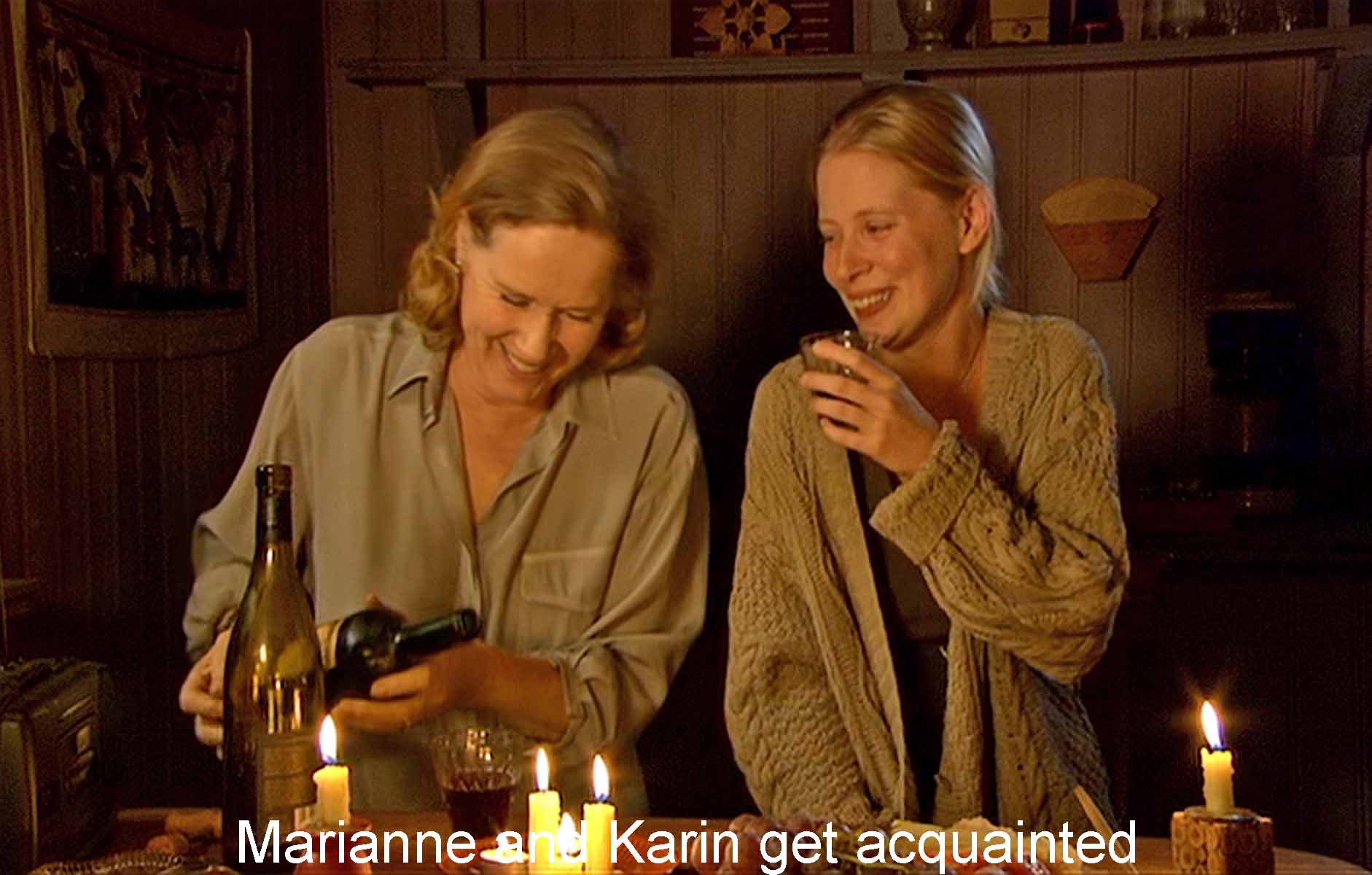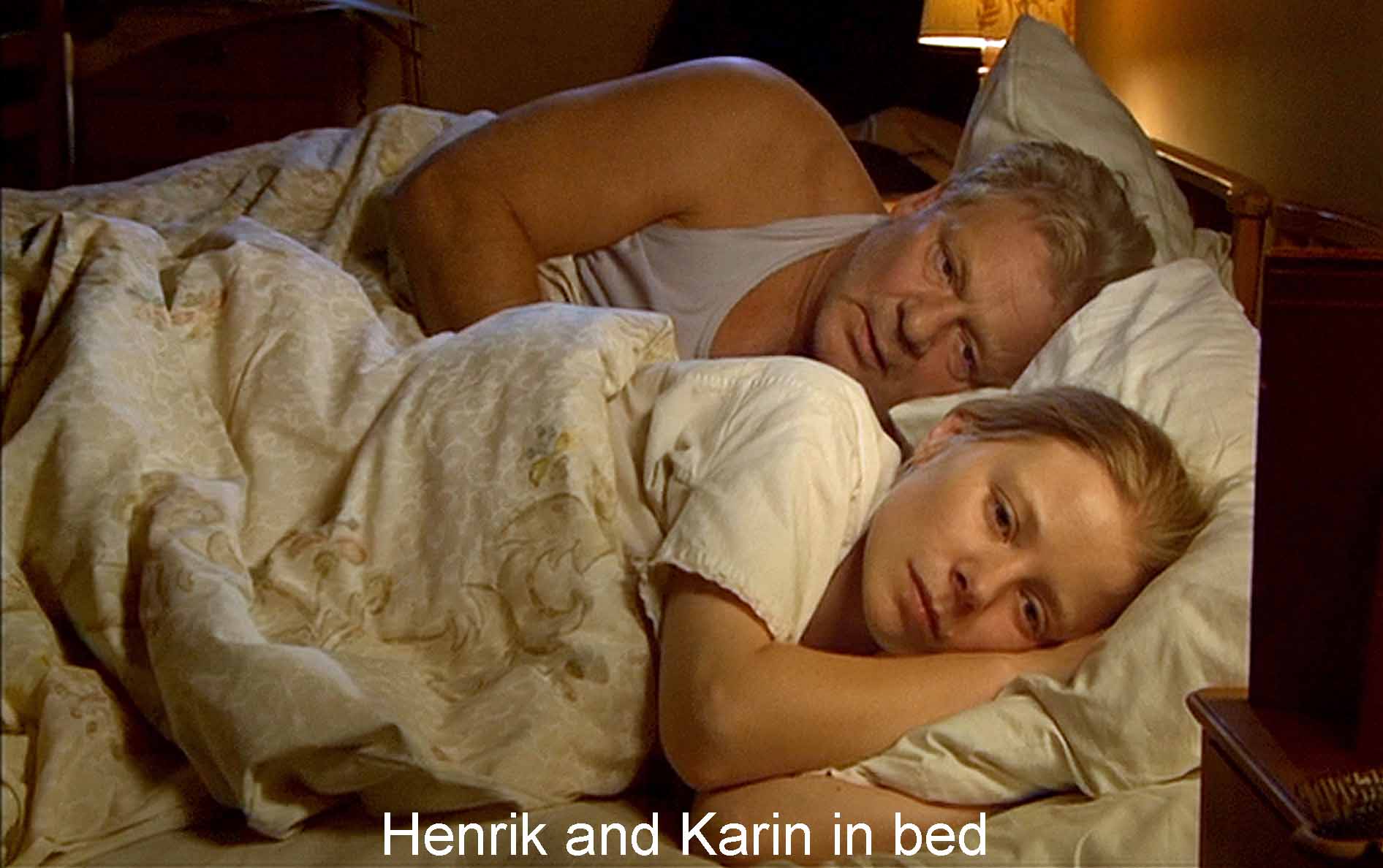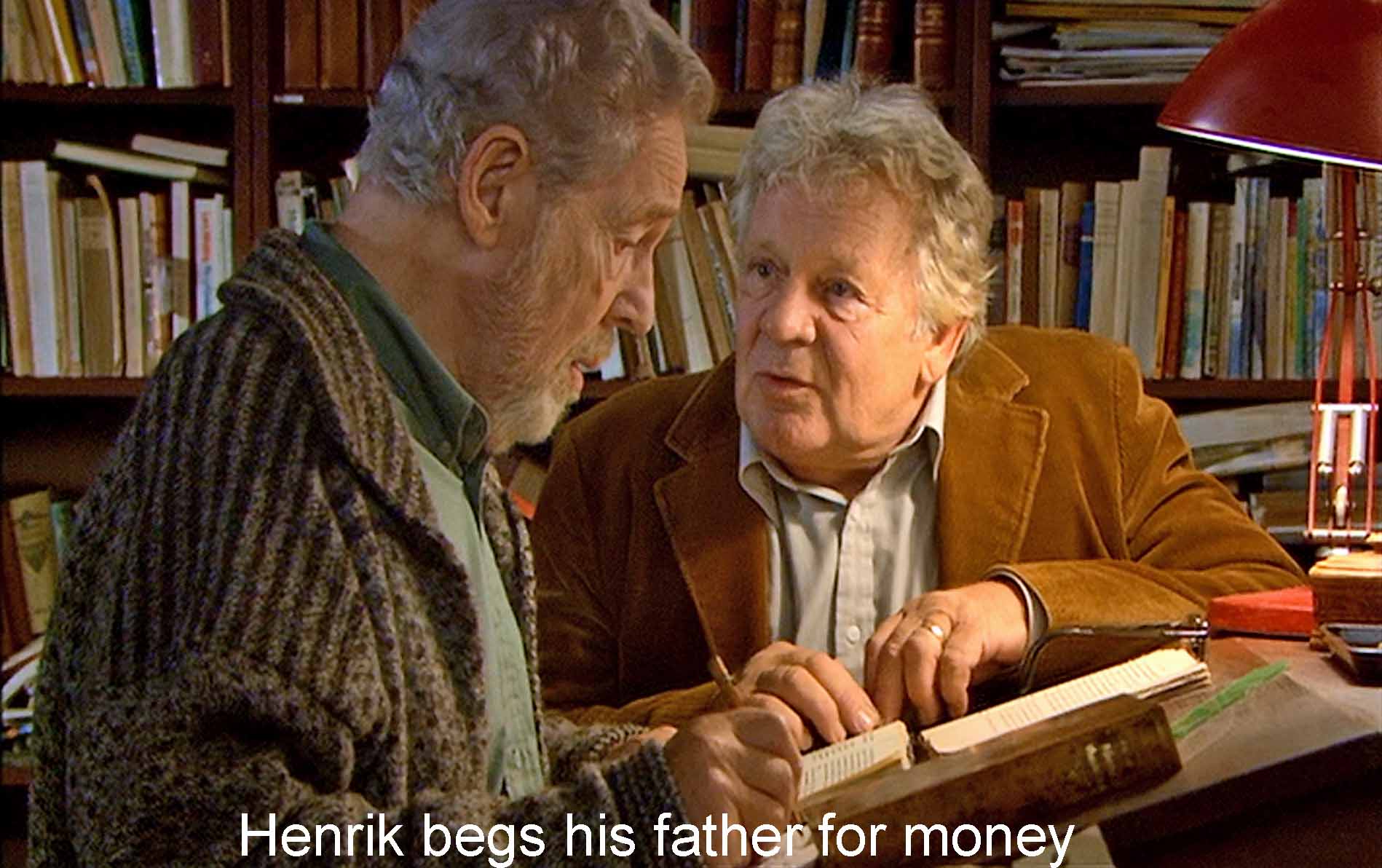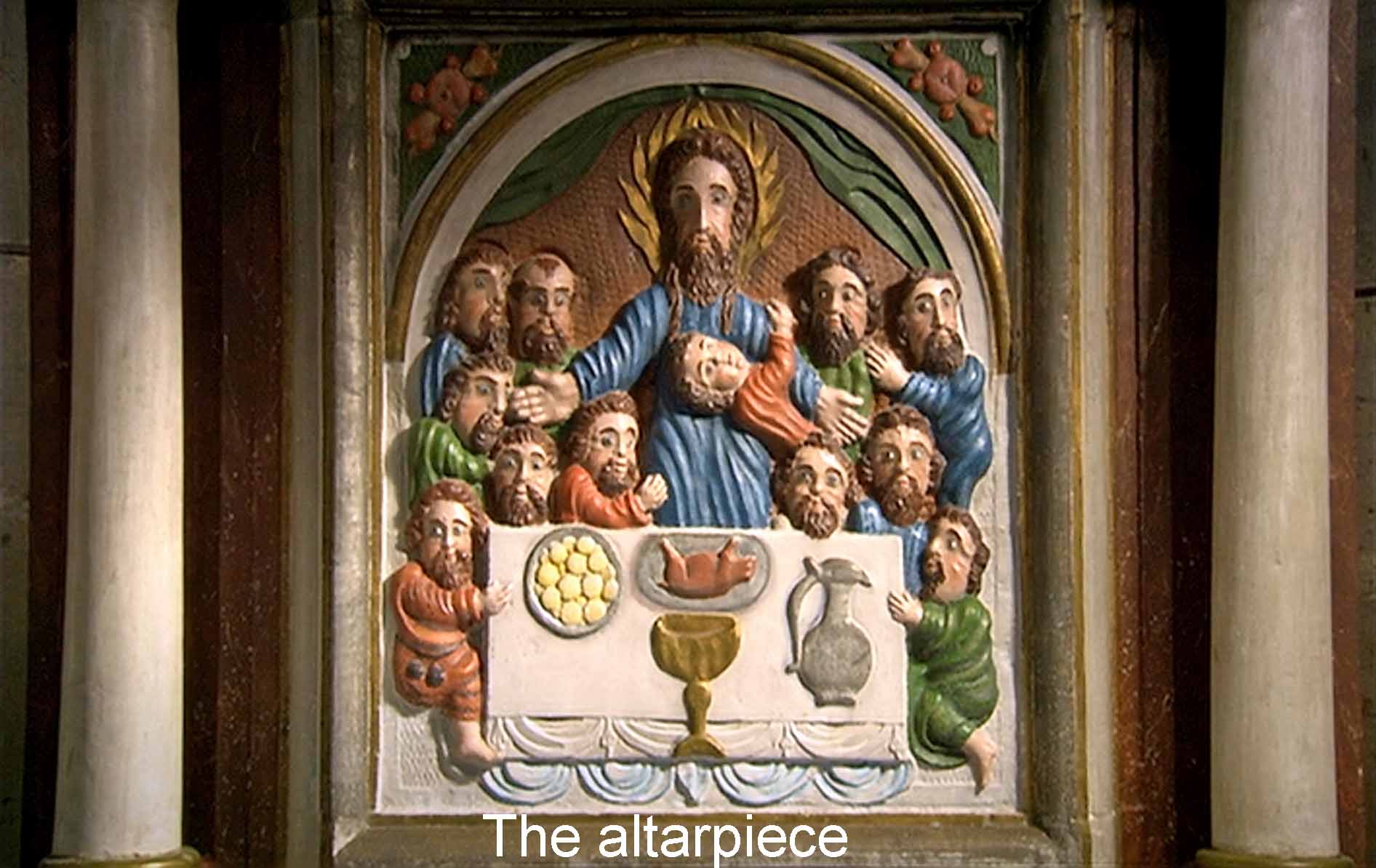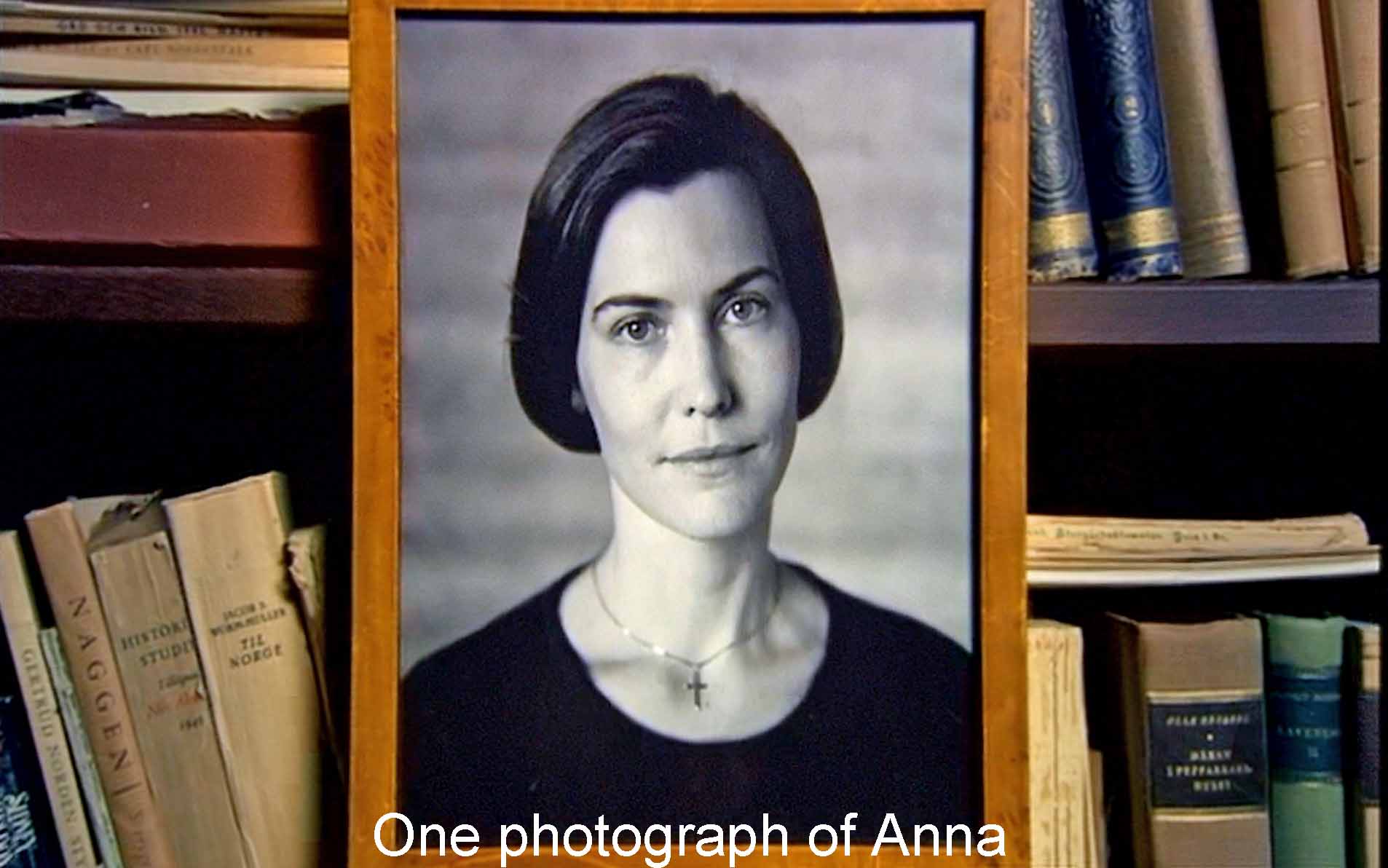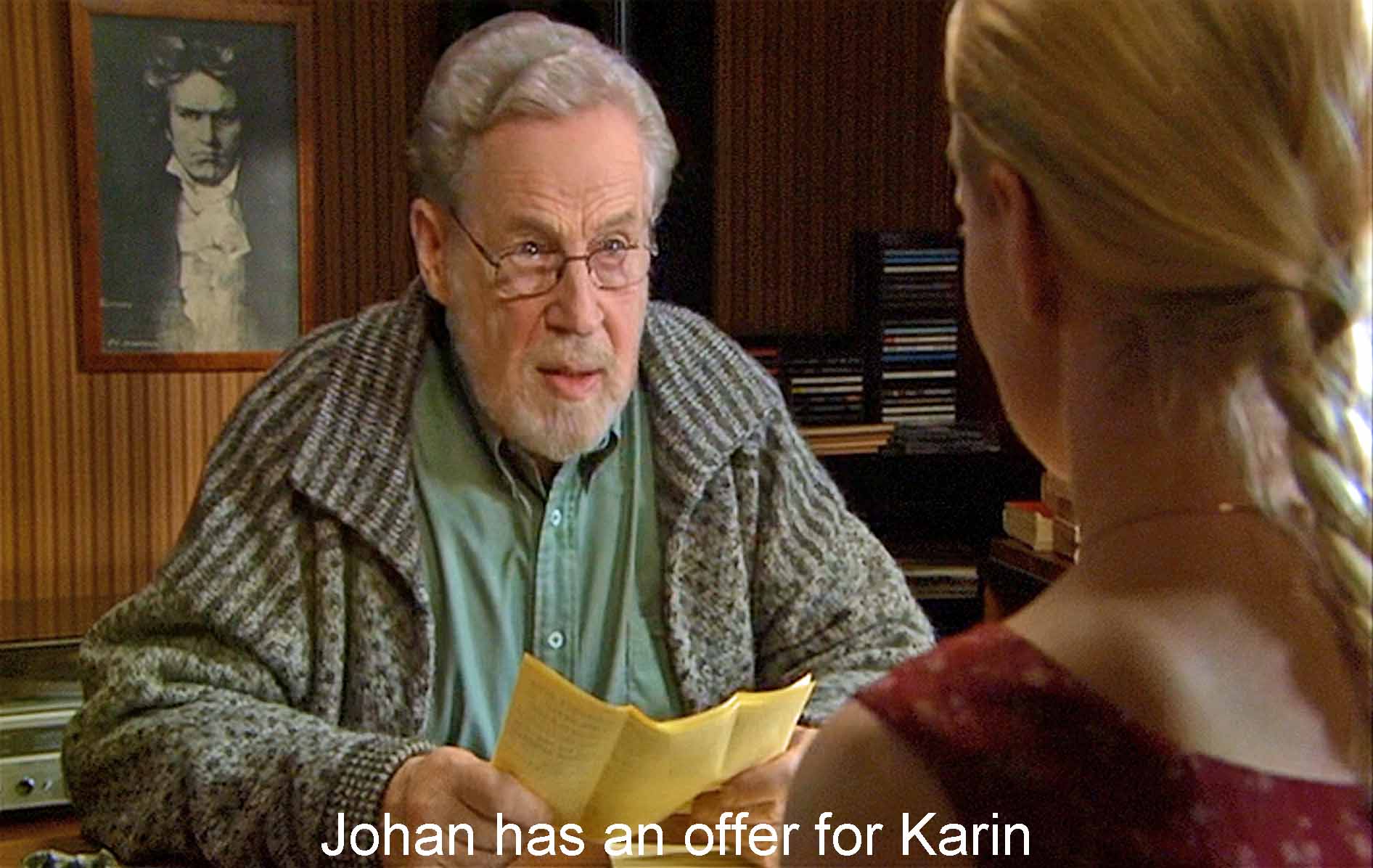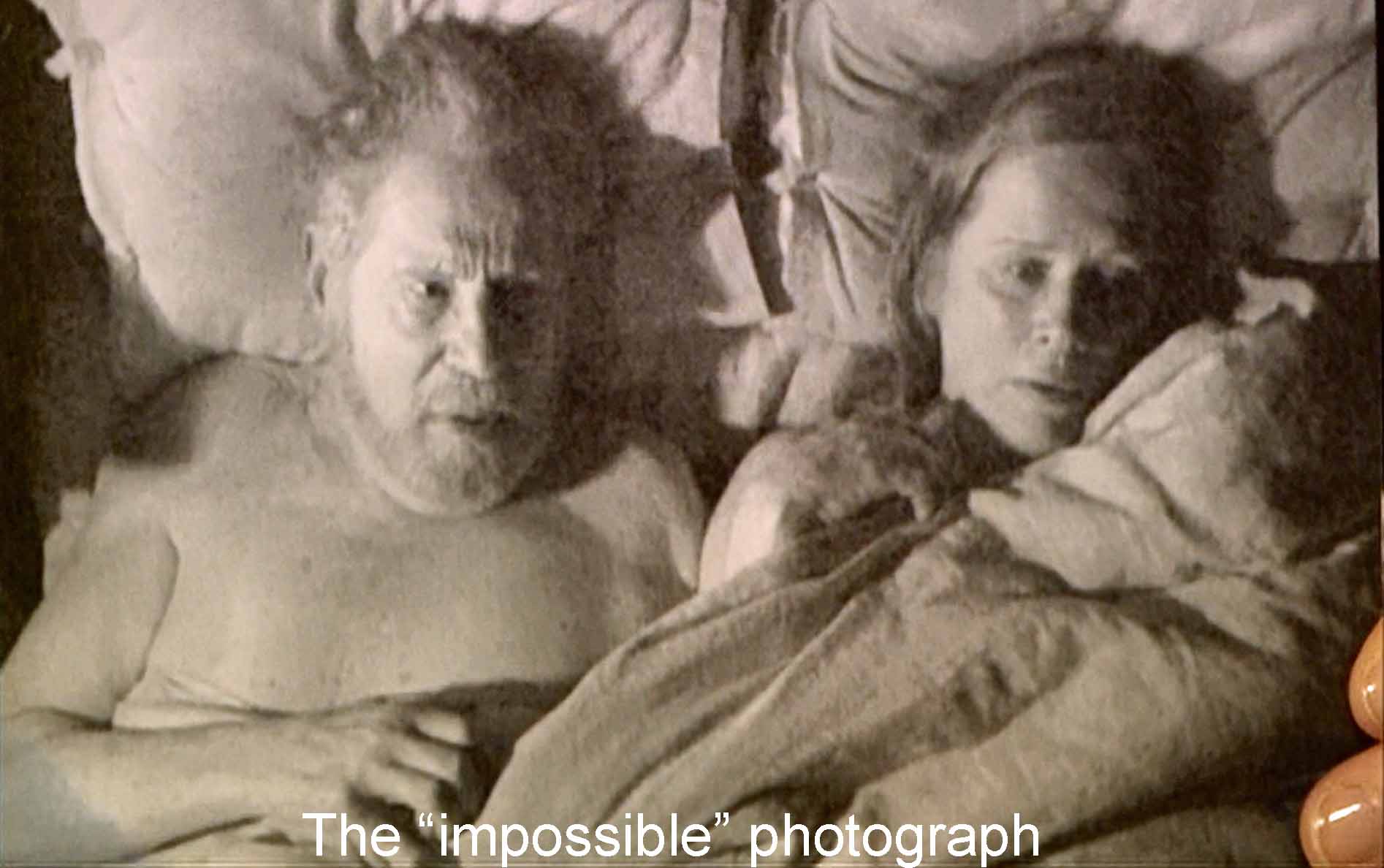It’s odd that still photographs should play such an important part in a motion picture and, at that, the testamentary motion picture by one of the greatest film directors of all time. But photography, after all, led into the motion picture, and it leads into this one. The opening shot is of a slew of photographs, some of them referring back to Bergman’s great success, Scenes from a Marriage of 1973.
Saraband is not so much a sequel to Scenes from a Marriage, as an adaptation of its two characters, Marianne (Liv Ullmann) and Johan (Erland Josephson), and their history to an independent film. On a whim, Marianne goes to visit Johan. He is now eighty-six, a rich, mean, despairing old man living in a house in the woods. His sixty-one year old son Henrik (Borje Ahlstedt in a particularly fine performance) lives in a cottage on the property, but Henrik and Johan feel nothing but hatred and contempt for each other. Living with Henrik is his nineteen-year-old daughter Karin (a debut by Julia Dufvenius). Henrik is preparing her for a career as a cello soloist. All three deeply mourn the death two years before of Anna, Karin’s mother, Henrik’s wife, who brought love into this troubled triad. Similarly, Marianne now provides a caring listener to all three. Karin learns that the smothering love of her father violates her beloved mother Anna’s last wishes. She abandons Henrik’s (and Johan’s) plans to make her a soloist, because she fears the humiliation she would suffer if she failed (a humiliation the soloist in Autumn Sonata describes). She wants the communal effort of an orchestra.
In the next-to-last sections 9 and 10 of Saraband, Henrik, defeated in his plans for his daughter, attempts suicide, but doesn’t die. Johan cruelly says this is just another of his failures. But that night, in the last section, he suffers a violent anxiety attack and comes like a scared little boy to Marianne’s bed. (This bed scene echoes an earlier scene, also of a man in emotional distress turning to a woman in bed, Henrik after a quarrel with Karin.)
Finally, in the epilogue, Marianne returns home and eventually—and indifferently—loses contact with Johan.
Bergman gives us this story in ten episodes, each labeled with a title card. Each episode consists of a dialogue between two of the four characters in the story. Bergman never has more than two people on the screen at a time. A prologue and epilogue frame the ten duets. One still photograph leads from the prologue to the main film and a second still leads from the main film back to the epilogue.
The first shot of Saraband shows us a tabletop with dozens and dozens of photographs strewn helter-skelter over its surface. Marianne (Liv Ullmann) walks into the frame and seats herself at the table. She holds up first one, then another, for our inspection: her former husband Johan, an old Danish aunt, their two daughters, herself as a pretty young woman. She tells us, in effect, that these pictures represent the chaos of human relations and emotions that she, as a domestic relations lawyer, knows all too well. The characters often speak of their emotions as though they were objects (like those photographs), as when Johan says, “My anxiety is bigger than I am—I’m too small for my anxiety. ” It will be the business of Bergman, and of Bach, to make artistic order out of this chaos.
One of the photographs, of Johan’s house in the forest, leads us into episode 1, Marianne’s arrival at Johan’s house. Conversely, a second still photograph, ends the ten episode-duets. Johan has had his anxiety attack and now begs Marianne to take him in her bed (like a frightened child coming to mommy). This is the one critics call “the impossible photograph,” for it shows Johan and Marianne in bed. (Who took the picture?! Bergman did, and that is the point.) Marianne may talk to the camera in the prologue and epilogue and first episode, but it is Bergman, the artist, who creates beauty out of this emotional turmoil.
The “impossible” photograph takes us to the epilogue, where we return to the tabletop covered with scattered photos, exactly the scene with which the film began. It is as though all this never happened. Marianne now assures us that everything is in good order, everything in its place. But this is an irony, surely. The photographs on the table are still scattered every which way, and the father, son, and granddaughter in the forest are anything but “in good order” after Henrik’s attempted suicide. Does Karin go back to him? We never find out.
Three times within the “diegetic” film, the characters look at a still photograph of Anna, Henrik’s wife and Karin’s mother who died two years previously. Neither Henrik nor Karin have gotten over her death. The characters’ looks at Anna’s picture are moments when one character is trying to be kind to another. Anna brings love and kindness and hope to these troubled people. In Saraband, as all through his career, Bergman portrays women as better than men in every emotional way: empathetic, forgiving, loving, and morally superior. They are especially better than men artists, like the womanizing Bergman himself. The picture of Anna, I have read, is in fact a picture of Bergman’s fifth wife, Ingrid von Rosen, to whom the film is dedicated. She was the love of his life, and this philandering man stayed married to her for twenty-three years.
Finally, there is a picture inserted in the film which is not a still, but might as well be. Johan has just offered Karin a chance at a Stradivarius-quality cello and study at the St. Petersburg conservatory. (Johan is trying do something good for Karin but also to woo her away from Henrik.) Karin sits down to reflect on the offer, and Bergman cuts to a moving picture with a stark white background, of Karin grown-up, performing as a soloist. The picture gets smaller and smaller until she disappears in a pinpoint. The picture tells us her state of mind, her decision to abandon both Henrik’s and Johan’s plans for shaping the rest of her life. Curiously, as Philip Lopate points out, Saraband has an age-old comic plot such as one would find in Molière or Shaw, freeing a young woman from the clutches of a greedy old man, here, two old men.
The still photographs introduce the idea of seeing, and the whole film derives from Marianne’s coming to see Johan. Within the film Karin meets Marianne when she comes to see Johan, Henrik is humiliated when he comes to see Johan, Karin is summoned to see her grandfather, Marianne sees a wood carving in the church, and so on. One can hardly make a motion picture without seeing.
What is unusual, though, are the two crucial letters in this film, one from the Russian conductor with an offer of training for Karin, the other a letter from the dying Anna to Henrik begging him not to seize on Karin (as he has done). Both are read aloud, but Bergman also gives us pictures of the text. We see as well as hear.
The film opens with Marianne looking at photos. It ends with a far more poignant seeing. Marianne has gone to see her schizophrenic daughter Marta (Gunnel Fred) in a mental hospital. Marianne touches her daughter’s cheek, removes her glasses, and Marta stares at her. Then she closes her eyes as if to go back into her interior world. When Marianne returns to the tableful of photos, she too closes her eyes. She too has gone back inside. The seeing is over. The film is over.
Photographs introduce still another theme of Saraband. A photograph necessarily deals with the past, and this is a film much concerned with the burden of the past upon the present. There is Marianne’s marriage to Johan and his long-standing hatred of his son. There are Marianne’s two lost daughters, one gone to Australia, the other confined to a mental hospital. Only Anna, from the past, is not a burden but a leavening.
Critics have pointed to confusions about time and the characters’ ages: Johan and Marianne would have had to marry when she was fifteen; the time for Johan’s quarrel with Henrik, a second wife’s son, when he was eighteen or nineteen is impossible. But I remember that Shakespeare has that kind of time confusion in Othello and Merchant of Venice, and I do not blush to allow Bergman the same leeway as Shakespeare.
Marianne’s tabletop full of scattered photos points to another theme of Saraband: the emotional chaos of Henrik’s relationships with Johan and Karin and even Marianne. Henrik is, to put it simply, a mess. So is his father who declares, “My life is shit. ” His overloaded shelves of books echo the chaos of Marianne’s photographs. Karin’s crazy run through the woods puts the emotional mess created by these people in physical form.
Bergman has portrayed ambivalence over and over, as if, for him, it is the norm in human relations, at least for men. Here, the two men portray the two sides of pathological ambivalence. Johan shows the vicious hatred, and “mushy” Henrik a smothering love with a hint of incest. Both would thwart Karin’s life, Henrik directly, Johan indirectly.
Contrast that tangle of emotions with Henrik’s and Karin’s efforts to create ordered beauty in the playing of the Bach Sarabande and his Organ Trio. The organ on which Henrik ostensibly plays is, I have read, an eighteenth-century organ, built by Johan Niclas Cahman, famous and prized in Sweden. Bergman uses the organ for emotional purposes, as he uses Karin’s playing. Even so, contrast the serenity and depth of the several Bach pieces with the violence of Bruckner’s Ninth that Johan listens to at a deafening level. Henrik claims to be writing a book about Bach’s St. John Passion, and the wood carving in the church where he and Marianne meet shows John (Johan!), the beloved disciple, leaning against Jesus’ chest at the Last Supper. As with the two letters, Bergman ties his aural and written art to the visual.
(There is a cute touch in that folk altarpiece. The table for the Last Supper holds bread, wine, and a chalice, but also a pig! A pig for a Passover dinner? I think the folk artist is following St. Paul, in Colossians, when he exempted Christians from Jewish dietary laws. The sculptor is saying that Jesus and his disciples are no longer Jews, but Christians!)
As the altarpiece shows, photography is only one of the arts portrayed in Saraband. Music dominates the film, and then there is Johan’s study with its chaos of books—he is reading Kierkegaard, another form of art. Then there is the strangely beautiful wood carving in the church where Marianne and Henrik talk. And, of course, the film itself. I think Bergman’s concept that shapes the film is the effort of artists and art to make beauty and coherence out of the chaos of human relationships. That involves using people, actors in movies, Bergman’s case, instruments and their players in music.
Bergman has filmic fun when Marianne comes to Johan’s house. He uses all kinds of clichés from horror movies: a woman entering a strange house, not knowing quite where to go. Doors mysteriously close. A cuckoo clock startlingly sounds; another clock ominously chimes. Marianne decides to wait a minute and times the minute with her watch. But it isn’t a minute at all. It’s thirty-two seconds. Bergman is showing us that he, the artist, controls it all, even time itself.
By contrast, emotional relations are chaotic in this film. Marianne has no idea why she has come to see Johan or whether she ever loved him. Johan hates his son, and the feeling is mutual. Both the father and the son use Karin for emotional purposes. Johan wants to humiliate his son by outdoing him in providing for Karin’s career as a soloist. And Henrik is suffocating Karin with his love. They even sleep in the same bed, and there is an unexpected and unwanted erotic kiss. Where lesser filmmakers use a parent’s sexually abusing a child to explain anything and everything, Bergman leaves open the question whether the relation between Henrik and Karin is sexual. But psychological abuse? That it surely is. And she escapes by choosing her own career, which is neither the one Henrik has mapped out for her nor the one Johan has maliciously opened up for her. And when she does, Henrik (as she and everyone else knew he would) tries to kill himself. Why, then, does Johan have an anxiety attack? Because of his son’s attempted suicide? Because of Karin’s departure? We don’t know. His anxiety is one more part of the mess.
Finally, then, what Bergman has done is create a work of art that makes beauty and significance out of a chaos of messy human emotions. And it begins with a tableful of still photographs.
You may well find it odd that I concentrate my reading of Saraband on a peripheral element, the still photographs in this motion picture. I’ve tiptoed around the obvious “big” themes of the film: parents and children, male and female. The last words of the film are, after all, Marianne’s sad “My child.” The story as a whole deals with a father’s and a son’s, Johan’s and Henrik’s mutual hatred and contempt, Karin’s escaping the smothering love of her father, and Marianne’s final mothering of Johan. The madonna-like picture of Anna—she wears a cross as Karin does—hovers over it all, offering hope or love—something better, whatever it is.
As always with Bergman, well, almost always, the women are wiser and kinder than the men, and the men are problematic and disordered. Here, the men need the touch, not necessarily sexual, of women’s bodies. The motif starts with Johan’s needing to hold Marianne’s hand when she first appears and escalates through Henrik’s sleeping beside Karin and culminates with Johan’s panicked climbing like a frightened four-year-old into Marianne’s bed. By contrast, the women are prudent, self-determining, and kind, and here the emblem of their influence is the recurring photograph of Anna.
My point in focusing on the still photographs (intended pun) is that Saraband is a beautifully, carefully wrought work of art in which even such a peripheral element leads you through all the rest. Then, too, there is something symbolic in writing about still photographs when, sadly, Bergman himself has been stilled. Saraband, his last work, captures for all time his art, as a photograph would, as Saraband and all his motion pictures do.

